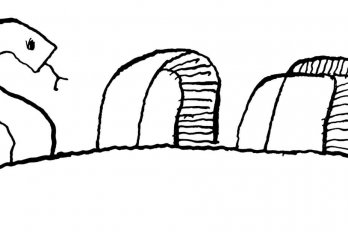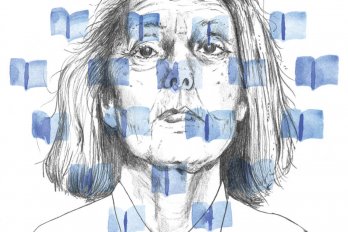A few hours before a special event at Milan’s Pinacoteca di Brera, James Bradburne is gliding along the entrance corridor with two guards and the receptionist in pursuit. I’ve joined them for a tour of the changes that have been implemented since he took over as director of the museum last fall. The fast pace of my visit, however, is not one Bradburne wants to model for visitors. Much of what he’s done is designed to help slow people down, to deepen their experience, to hold their gaze.
At a time when cultural institutions face pressure to be popular—and profitable—Bradburne eschews many of the usual administrator’s tricks. He’s not interested in blockbuster-style shows. And he doesn’t want busloads of people in the galleries at once. “Museums are not part of the leisure industry,” he says. “They are a fundamental part of who we are. They are a part of how we learn to have different discussions about the world. If we forget that, and if we just become experience vendors, we’ve set the bar far too low.”
The Brera, home to works by Titian, Bellini, Raphael, and Caravaggio, has the most impressive collection of Italian Renaissance paintings in Milan; however, it currently isn’t well known outside the art world. Last year, the Italian government partly freed twenty state museums from a centralized bureaucracy and hired new directors such as Bradburne to reinvigorate them. These appointees have been tasked with making Italy’s historic artistic legacy relevant to a contemporary audience.
Bradburne, who grew up in Toronto before embarking on a career that would take him across Canada, the United Kingdom, and Europe, previously spent ten years as the director of the Palazzo Strozzi in Florence, an exhibition space that he developed into a vibrant cultural hub. Before that, he worked at museums in Frankfurt and Amsterdam and at a foundation in London dedicated to creativity and learning. Having thought for a long time about the role of the museum in the world, he is well aware of the function of the gift shop and of the need to attract private funding—but he notes that these are not germane to the museum’s essential reason for existence. “We’re not just consumers,” he says. “It’s our role to create a society that remembers its past and learns from it, to be a place where people see the effect of creativity, of tolerance, and of exchange. We are trying to create a better world.”
The Pinacoteca di Brera’s collections date back to 1776. When Napoleon Bonaparte was crowned king of Italy in 1805, he envisioned it becoming a counterpart of the Louvre. Bradburne’s immediate mandate is to position it at the cultural centre of Milan. He won’t measure success with what he calls the “banality” of turnstile counts. Instead, he hopes that locals will make repeat visits and that the museum will become an important part of every art lover’s tour of Italy. He will keep an eye on the numbers, but mostly to ensure that there haven’t been too many visitors at once. “If you have too many people on a single day, they don’t get out of the paintings what is there to be given,” he says. “They shuffle through a crowded room, and no one is transformed.”
Transformation is a recurring concept in Bradburne’s vision. As a child, he was taken to Expo 67 in Montreal; in the Red Cross pavilion there, he was moved by the sound of a human heart beating quietly. “Every art historian was once an eight-year-old child who saw a painting and fell in love,” he says.
The transformation of the Brera is rooted in logistical concerns. Bradburne, a trained architect, solved an internal design problem that led visitors, via signage, away from the museum’s natural entrance. This fall, they will be able to walk through the museum’s central door, buy a ticket from a well-marked biglietteria, and walk through new glass doors that protect the climate-controlled inner rooms from sudden gusts of air—the main rationale for the previous arrangement. This will set the scene for a new café, which will encourage people to linger rather than to race through the museum in the traditional visitor’s hour.
Bradburne has repainted, using dark red for the walls of the medieval collection and the blue of a Madonna’s robe in the fifteenth-century room. He points specifically to the hue in a painting by Andrea Solario as his inspiration for the latter. The effect is dramatically different from the one created by the museum’s older, bland, greyish-white tones. “The staff think I’m mad,” he says. “They trust me—they know I’ve been doing this for years—but they still think I’m mad.”
In the pre-Bradburne galleries, paintings were often crowded together, and the labels were tiny. The new arrangement offers writerly descriptions of the works in easy-to-read type—some by respected international authors such as the British novelist Sarah Dunant, a co-founder of the Orange Prize, and Ingrid Rowland, a classicist. These should help extend the average viewer’s attention em (according to a study conducted at the Metropolitan Museum of Art in New York, museum-goers spend an average of seventeen seconds looking at a single work of art).
Bradburne, the museum’s curators and restorers, and even its security guards have discussed numerous projects designed to focus attention on particular paintings. One idea involves creating what they call dialogues among a few related artworks.
Andrea Mantegna’s Lamentation over the Dead Christ, from the late fifteenth century, is one of the most important paintings in the Brera’s collection. It is famous in part because of its composition: the viewer stands as if at Christ’s feet, looking up at his body, which is laid out flat on a marble slab. Christ’s wounds have stopped bleeding, and the flesh looks cold, as if rendered in death-coloured paint. In the gallery’s current installation, the painting hangs opposite Annibale Carracci’s Corpse of Christ (1585), which was clearly influenced by the earlier painting, though Carracci’s Christ is bent and his wounds are bloody.
Bradburne borrowed the Carracci from Stuttgart to highlight the influence of Mantegna. He also borrowed Orazio Borgianni’s 1615 painting on the same theme from Rome. The three paintings have never before been hung together. After viewing them, I wandered around and noted other works by Mantegna and by his brother-in-law Giovanni Bellini. I left with the impression of having seen something of substance, rather than of simply having seen too much.
Bradburne invited Clive Britton, a British pianist and the former artistic director of a large regional Italian orchestra, to create a program relevant to the paintings. Britton brought in a small orchestra to perform Venetian music—Vivaldi, Paganini, Salieri—so as to emphasize the connections Carracci and Mantegna have with Venetian painting. Such music, he says, represents “an attempt to know, to tie in relationships and links.”
Live performances in galleries often result in a kind of “background music” effect, but in this case, the interplay of sound and image creates an independent work of art. Its sincerity stands in contrast to the consumer-driven approach to art consumption, which bestows cultural capital on those of us who go to the latest touring show with lineups around the block and its own hashtag. Bradburne is after a more lasting and ambitious project, something that was once understood by kings and popes.
“Everything [today] has to be made comfortable and accessible. But we’re forgetting what art is really all about,” says Britton. “James never talks down to people, but at the core, he has a clear idea of the power contained in great art. Great art is powerful. And it can be for everyone, but you have to work towards it.”
The fact that Bradburne’s project cannot be reduced to straightforward consumer metrics means that its successes may be hard to quantify. By his own measure, the goals of the museum may be met many times a day—but how to account for the transformation of the human psyche? Only the individual visitor will ever know for sure.
This appeared in the October 2016 issue.





